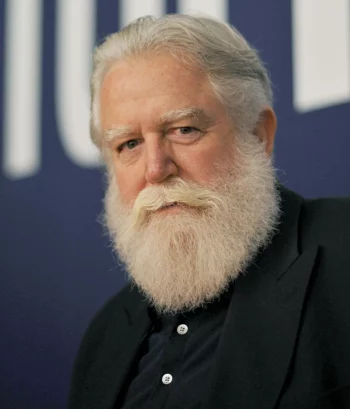
By Brian Nixon —
California-born, Arizona-living, Quaker artist James Turrell (b. 1943) may reside seventeen driving hours away from Houston, Texas, but ‘Space City’—more than any other municipality—is home to a concentration of the artist’s works unlike any other place in the world. As a matter of fact, The Museum of Fine Arts, Houston (MFAH) holds the largest repository of Turrell’s works on the planet.
Concerning Fine Arts Museum, Houston’s connection to Turrell, the museum website states, “The MFAH has had a long and rich history with James Turrell…beginning in 1994 with acquisition of the artist’s First Light portfolio. The museum’s 1996 purchase of the Peter Blum Edition Archive…brought more than 100 major prints, working proofs and printing plates by Turrell into the museum’s collection. In 1999, MFAH patrons Isabel B. and Wallace S. Wilson commissioned Turrell’s The Light Inside to link the Caroline Wiess Law Building with the then-newly built Audrey Jones Beck Building. The museum has continued to maintain its commitment to Turrell with other significant purchases, including the 2008 purchase of Acro, Green (1968) from the artist’s “Projection” series. In 2010 the MFAH made the commitment to acquire the artist’s “Vertical Vintage,” a career-spanning survey of twelve light-based installations, a landmark for Houston…”

It’s a fitting connection. As a leader in the Light and Space artistic movement, Turrell has spent his entire career pursuing the light, as his Quaker grandmother would encourage him. And Houston, with NASA leading the way, has spent much of the 20th century pursuing space.
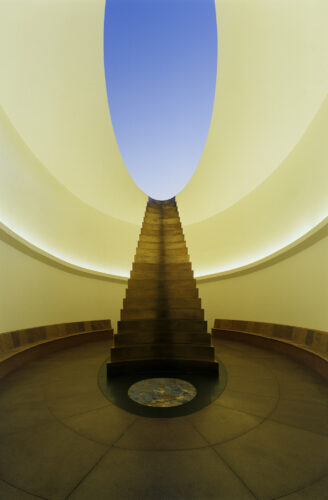
With its emphasis on perception, light, and tech-oriented medium, the Light and Space movement began in Southern California, but has influenced countless of contemporary artists around the world, integrating science, technology, nature, and aesthetics in bold forms, leading to Turrell’s Magnus opus, Roden Crater, in Arizona.
On a recent trip to Houston, I was able to view many of Turrell’s larger works, including Twilight Epiphany at Rice University, The Light Inside, projection pieces, and several printed works at the Fine Arts Museum, Houston, and most notably, Skyspace at the Live Oaks Friends Meetinghouse.
To pick one Turrell over the other would be very difficult; all were marvelous. But if pressed, I’d pick Skyspace at the Live Oaks Friends Meetinghouse (at least this time). Why? I enjoyed the simplicity of the design in congruence with a worship space, a place dedicated to Slow Church (deep engagement with God, people, and place) and Slow Art (a term often used with Turrell’s work, an expression for art that encourages stillness).
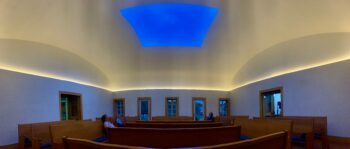

Live Oaks Friends Meetinghouse opens Skyspace each Friday for the public. I arrived at roughly 6:00. A few other people congregated. One woman asked where “Turrell would sit?” The usher brought her to the pew. Together, we sat in silence and looked to the heavens. For my part, I prayed, thanking God for His marvelous creation—and inspiration—for places of solace. Some reposed on the pews, others just stared in silence as the light began to shift from light to dark.
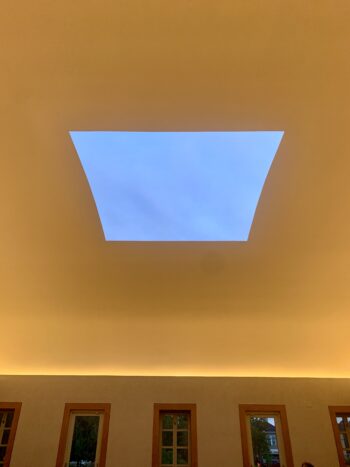
During the endeavor, my mind went back to a seminary class I took at the Friends Center via the Haggard School of Theology. I remembered a quote by the founder of the Friends/Quakers, George Fox, whereby the word “light” was a reference to Jesus:
“The first step to peace is to stand still in the Light.”
Quakers sought the Light of Christ, a reference to God’s presence with His people, finding the “Light within” and sharing it with others.
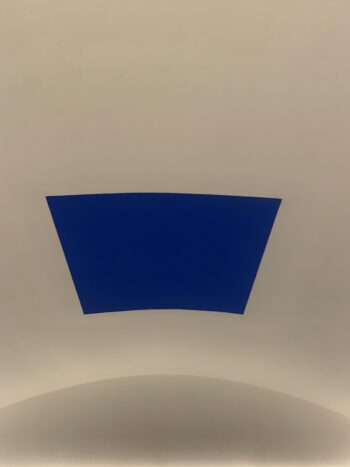
As I rested in the Live Oaks Friends Meetinghouse, I was able to stand—and sit—in the Light, thanking God for the generous moment of harmony; a peace that passes all understanding.
To hear from Turrell concerning his art, watch this short introductory video by the Guggenheim Museum: https://www.youtube.com/watch?v=udlzm3Ea3RE.



